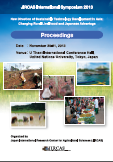The Evolution of Food Consumption and the Direction of Food Technology Development in China

China is the world’s most populous country. Since its reforming from 1978, Chinese residents’ food
consumption has undergone enormous changes. China’s food consumption is not only a matter of concern
to the development of the nation’s agriculture, but also influences the world’s agricultural markets while
China’s agricultural imports increase rapidly in recent years. It is crucial to grasp the changes in food
consumption trends in China. Therefore, this paper tends to summarize the resident’s food consumption
characteristics with the data provided by FAO, OECD, the World Bank and China Statistical Yearbook.
However, it’s not enough to reflect the overall Chinese consumption characteristics of different groups.
Because of China’s long-standing urban-rural dual structure and the rapid development of urbanization in
China, China has three consumer groups, such as citizens, farmers and migrant workers, so this article
analyzes the gap of food consumption between urban and rural residents, and gives a brief description of
migrant workers’ food consumption. On this basis, this paper analyzes the reasons why changes occur and
why differences exist between urban and rural residents. At the end, we will predict Chinese food
consumption trends of the future, and propose development direction of Chinese food technology accordingly.
After our analysis, structure upgrading, quality improvement and diversification in consumption
patterns are the three main changes. Upgrades in the structure: direct consumption of grain reduction,
indirect consumption increasing; animal food grew faster than plant food. On the quality improvement:
the quality of food improves continuously and residents concern food safety more closely. On diversification:
Eating out expenditures rose; purchases of imported food are increasing. But under the overall trends,
there is a huge difference between urban and rural residents, especially in meat, poultry eggs and milk, and
the gap is narrowing because of the lack of eating out and non-purchase of real spending data. Food
consumption expenditure of migrant workers is high, but the food structure is not yet sure due to lack of
data.
Research shows that changes of Chinese food consumption depend mainly on the income increase and
the level of urbanization in rising China. In addition, food preferences and the Chinese food market also
contributed to the improvement of China’s food consumption changes. Differences between urban and
rural food consumption are related to income differences, food availability and consumption concept.
Trends in China’s future food consumption will continue: First, rations continue to reduce, steering to
increase feed, processing grain; animal food consumption continues to increase. Second, requirements for
food quality further improve; demand for fresh food, processed food, safe food will be further expanded,
and the demand for food safety will be higher. Third, consumption of eating out and imported food will
rise. Therefore, the Chinese food technology development directions are: 1) increase production technology
to guarantee both quantity and quality; 2) improve and innovate processing technologies; and 3) develop
refrigerated cold chain technology.
| Date of issued | |
|---|---|
| Creator | Yingheng Zhou |
| Subject |
Food Consumption Trends Technology |
| Publisher | Japan International Research Center for Agricultural Sciences |
| Available Online | |
| Issue | 2013 |
| spage | 59 |
| epage | 69 |
| Rights | Japan International Research Center for Agricultural Sciences |
| Language | eng |
